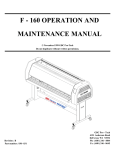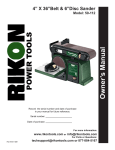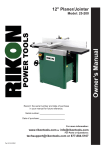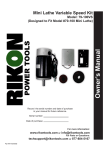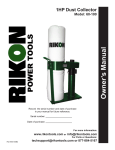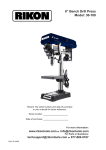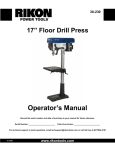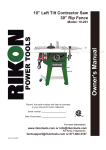Download Rikon Power Tools 70-100 Owner`s manual
Transcript
1”x42” Belt / 8” Disc Sander Owner’s Manual Model: 50-142 Record the serial number and date of purchase in your manual for future reference. Serial number: Date of purchase: For more information: www.rikontools.com or [email protected] For Parts or Questions: [email protected] or 877-884-5167 Part # 50-142M1 Safety Warning IMPORTANT! Safety is the single most important consideration in the operation of this equipment. The following instructions must be followed at all times. There are certain applications for which this tool was designed. We strongly recommend that this tool not be modified and/ or used for any other application other than that for which it was designed. If you have any questions about its application, do not use the tool until you have contacted us and we have advised you. General Safety Warnings KNOW YOUR POWER TOOL. Read the owner’s manual carefully. Learn the tool’s applications, work capabilities, and its specific potential hazards. ALWAYS GROUND ALL TOOLS. If your tool is equipped with a three-pronged plug, you must plug it into a three-hole electric receptacle. If you use an adapter to accommodate a two-pronged receptacle, you must attach the adapter plug to a known ground. Never remove the third prong of the plug. ALWAYS AVOID DANGEROUS ENVIRONMENTS. Never use power tools in damp or wet locations. Keep your work area well lighted and clear of clutter. ALWAYS REMOVE THE ADJUSTING KEYS AND WRENCHES FROM TOOLS AFTER USE. Form the habit of checking to see that keys and adjusting wrenches are removed from the tool before turning it on. ALWAYS KEEP YOUR WORK AREA CLEAN. Cluttered areas and benches invite accidents. ALWAYS KEEP VISITORS AWAY FROM RUNNING MACHINES. All visitors should be kept a safe distance from the work area. ALWAYS MAKE THE WORKSHOP CHILDPROOF. Childproof with padlocks, master switches, or by removing starter keys. NEVER OPERATE A TOOL WHILE UNDER THE INFLUENCE OF DRUGS, MEDICATION, OR ALCOHOL. ALWAYS WEAR PROPER APPAREL. Never wear loose clothing or jewelry that might get caught in moving parts. Rubber-soled footwear is recommended for the best footing. ALWAYS USE SAFETY GLASSES AND WEAR HEARING PROTECTION. Also use a face or dust mask if the cutting operation is dusty. NEVER OVERREACH. Keep your proper footing and balance at all times. NEVER STAND ON TOOLS. Serious injury could occur if the tool is tipped or if the cutting tool is accidentally 2 ALWAYS DISCONNECT TOOLS. Disconnect tools before servicing and when changing accessories such as blades, bits, and cutters. ALWAYS AVOID ACCIDENTAL STARTING. Make sure switch is in “OFF” position before plugging in cord. NEVER LEAVE TOOLS RUNNING UNATTENDED. ALWAYS CHECK FOR DAMAGED PARTS. Before initial or continual use of the tool, a guard or other part that is damaged should be checked to assure that it will operate properly and perform its intended function. Check for alignment of moving parts, binding of moving parts, breakage of parts, mounting, and any other conditions that may affect its operation. A guard or other damaged parts should immediately be properly repaired or replaced. Special Safety Rules For Sanders 1.Do not operate this machine until you have read all of the following instructions. 2.Do not attempt to operate this machine until it is completely assembled. 3. Do not turn ON this machine if any pieces are missing. 4. If you are not familiar with the operation of the machine, obtain assistance from a qualified person. 5.It is highly recommended that this machine be placed on a level surface. 6.Always wear protective eyewear prior to operating this machine. 7.Do not operate this machine if you are under the influence of drugs and/or alcohol. 8.Remove all jewelry prior to operating this machine. 9.Do not wear any gloves while operating this machine. 10.Always make sure the power switch is in the OFF position prior to plugging in the machine. 11.Always make sure the power switch is in the OFF position when doing any assembly or setup operation. 12.Always wear a dust mask when cleaning or working near a sander. 13.The use of any accessories or attachments not recommended may cause injury to you and damage your machine. 14.This machine must be properly grounded. 15.Always keep your face and hands clear of moving parts such as sanding belts and discs. 16.Keep these instructions for future reference. California Proposition 65 Warning WARNING: Some dust created by power sanding, sawing, grinding, drilling, and other construction activities contains chemicals known to the State of California to cause cancer and birth defects or other reproductive harm.Your risk from exposure to these chemicals varies, depending on how often you do this type of work. To reduce your exposure, work in a well-ventilated area and with approved safety equipment, such as dust masks that are specially designed to filter out microscopic particles. For more detailed information about California Propostion 65 log onto rikontools.com. SAVE THESE INSTRUCTIONS. Refer to them often. 3 Table of Contents Safety Warnings......................................................................................................................................2-3 Safety Rules for Sanders............................................................................................................................... 3 Specifications.........................................................................................................................................................4 Unpacking and Contents..................................................................................................................................... .5 Getting to Know Your Sander..........................................................................................................................6 Assembly................................................................................................................................................................ 6-10 Operations......................................................................................................................................11-13 Adjustments.........................................................................................................................................................14 Maintenance..........................................................................................................................................................15-16 Wiring Diagram......................................................................................................................................16 Electrical Requirements...................................................................................................................................17 Explosion Diagram..............................................................................................................................................18-19 Parts List...............................................................................................................................................................20-21 Warranty.................................................................................................................................................................22 Notes....................................................................................................................................23 Specifications Model Number Belt Size Belt Speed Disc Size Disc Speed Hose Inlet Motor HP Motor Volts/Amps Net Weight 50-142 1” x 42” 3,000 FPM 8” 1,725 RPM 2” 1/3HP 110V/4A 58.5lbs 4 Contents of Package Unpacking and Checking Contents Unpack your sander from its carton and check to see that you have all of the following items. Do not turn your sander ON if any of these items are missing. You may cause injury to yourself or damage to your machine. A C B D E A. Motor and Base B. Belt Housing Assembly C. Disc Table D. Belt Table E. Motor Belt Cover F. Sanding Disc, 8” G H J I L M G. V-Belt Rear Cover H. Dust Port, 2” I. Disc Dust Cover J. Miter Gauge K. Table Lock Handles L. Hex Wrench 2.5MM M. Hex Wrench 8MM 5 K F Getting to Know Your Sander B A F C D E G P O N M L K Item Description Item A. B. C. D. E. F. G. H. Sanding Belt 1” x 42” Sanding Belt Tracking Knob Sanding Disc 8” Miter Gauge Disc Table V-Belt Safety Cover Sanding Belt Safety Cover Sanding Belt Dust Port I. J. K. L. M. N. O. P. H J I Description Motor Disc Table Angle Scale Disc Table Lock Handle Disc Dust Port ON/OFF Switch with Disabling Key Rubber Machine Feet Sanding Belt Table Lock Handle Sanding Belt Table Assembly The sander must not be plugged in and the power switch must be in the OFF position until assembly is complete. Unpacking and Clean-up 1. Carefully finish removing all contents from shipping carton. Compare contents of the shipping carton with the list of contents above. Place parts on a protected surface. 2. Report any shipping damage to your local distributor. 3. Clean all rust protected surfaces. Do not use; gasoline, paint thinner, mineral spirits, etc. These may damage painted surfaces. 4. Set packing material and shipping carton to the side. Do not discard until machine has been set up and is running properly. 6 Assembly To assemble your 50-142 sander: 1. Using 13mm wrenches, loosen the four motor mount hex bolts (Figure 6) so you can adjust the motor position in the next steps. 2. With assistance, position the belt housing assembly on the left side of the base, taking care not to pinch the power cords between the assembly and the base. Motor Mounting Hex Bolts 2 of 4 Fig. 06 3. Place the V-belt around both pulleys, and secure the belt housing assembly with the two M10-1.5 x 20 cap screws, lock washers, and flat washers (see Figures 7 & 8)—do not fully tighten the fasteners for now. 4. Center the motor arbor in the cutout of the cast iron disc guard (see Figure 9), then re-tighten the motor mount hex bolts. Fig.07 Belt Housing Assembly 5. Position the belt housing assembly so there is about 1⁄4" V-belt deflection when moderate pressure is applied to the V-belt between the pulleys (see Figure 10)—then fully tighten the cap screws to secure the belt housing assembly in place. Base Fig.08 6. Insert one M4-.7 x 10 Phillips head screw and flat washer into the left inside mounting bracket of the V-belt safety cover (see Figure 11). Then hold it in place with a screwdriver as you slide the cover over the V-belt and tighten the fastener into the cast iron disc guard. Set Screw Access Hole 7. Secure the right side of the V-belt cover with one M4-.7 x 10 Phillips head screw and flat washer. Fig. 09 Pulley 8. Position the V-belt rear cover, as shown in Figure 12, and secure it in place with the M4-.7 x 40 Phillips head screw and wingnut. Deflection 9. Slide the aluminum disc onto the motor arbor, making sure to align the arbor key with the disc keyway. Pulley Fig. 10 7 Assembly 10. Rotate the disc until you can see the set screw through the hole on the back of the V-belt safety cover (see Figure 13) 11. Using the 2.5mm hex wrench, tighten the set screw to secure the disc to the motor arbor. Fig.11 12. Install the disc dust cover, as shown in Figure 14, with three M4-.7 x 10 Phillips head screws and flat washers. Wing Nut 13. Lay the sander down on a flat surface, as shown in Figure 15, and place a thin piece of cardboard approximately 1⁄16” thick over the sanding disc. This piece of carboard will act as a spacer when you install the disc table. V-Belt Fig.12 14. Keeping the cardboard in place, align the half-arc key of the disc table with the indented keyway on the disc guard (see the inset of Figure 16). Then secure the table with a table lock handle, and remove the cardboard. Set Screw Access Hole Fig.13 15. Secure the dust port, as shown in Figure 17, with the M6-1 x 15 Phillips head screw and flatwasher. Mounting Screws 16. Square the disc table to the sanding disc (refer to Squaring Disc Table on Page 14). Fig.14 17. Using the M4-.7 x 10 Phillips head screw, align the red scale pointer with the “0” mark on the table angle scale (see Figure 18). Cardboard 18. Install the belt table with a 1⁄16” clearance from the sanding belt, and secure it in place with the table lock handle (see Figure 19). Fig.15 19. Loosen the cap screw shown in Figure 20, adjust the belt support approximately 1⁄16” away from the sanding belt, then re-tighten the cap screw. Keyway Key Table Lock Fig.16 8 Assembly Test Run After Assembly Once the assembly is complete, test run your sander to make sure it runs properly and is ready for regular operation. If you have questions regarding assmbly before operating the sander, contact RIKON Tech Support at 877-884-5167 for assistance. Mounting Screw Fig.17 To test run the sander: 1. Make sure you have read the safety instructions at the beginning of the manual and that the machine is setup properly. Pointer 2. Make sure all tools and objects used duringsetup are cleared away from the machine. 3. Connect the machine to the power source. Fig.18 4. Verify that the machine is operating correctly by turning the machine ON. —When operating correctly, the machine runs smoothly with little or no vibration or rubbing noises. — Investigate and correct strange or unusual noises or vibrations before operating the machine further. Always disconnect the machine from power when investigating or correcting potential problems. Fig.19 5. Turn the machine OFF. Belt Support 6. Remove the switch disabling key, as shown in Figure 21. Cap Screw 7. Flip the toggle switch to the ON position. This will ensure that the safety function is working properly. Fig.20 8. When the Test Run has been successfully completed, check the tracking of the sanding belt and make adjustments if necessary (refer to Sanding Belt Tracking on Page 12). Fig.21 9 Assembly Mounting Sander Once you have confirmed that your machine is running properly, mount it to a workbench. The strongest mounting option is a "Through Mount" where holes are drilled all the way through the workbench, and hex bolts, washers, and lock nuts are used to secure the sander to the workbench. Another option for mounting is a “Direct Mount” where the machine is simply secured to the workbench with a lag screw. Note: To reduce vibration when operating, keep the rubber cushion included with your sander between the machine base and the workbench. Fig.22 Dust Collection To connect a dust collection hose: 1. Install a 2” dust hose from a dust collection system over each dust port, and secure them in place with a 2” hose clamp. 2. Tug the hoses to make sure they do not come off. CAUTION DO NOT operate this sander without an adequate dust collection system. This sander creates substantial amounts of wood dust while operating. Failure to use a dust collection system can result in short and long-term respiratory illness. Fig.23 California Proposition 65 Warning WARNING: Some dust created by power sanding, sawing, grinding, drilling, and other construction activities contains chemicals known to the State of California to cause cancer and birth defects or other reproductive harm.Your risk from exposure to these chemicals varies, depending on how often you do this type of work. To reduce your exposure, work in a well-ventilated area and with approved safety equipment, such as dust masks that are specially designed to filter out microscopic particles. For more detailed information about California Propostion 65 log onto rikontools.com. 10 Operations Disc Sanding CAUTION Always keep the workpiece on the left side of the wheel that rotates down toward the table. This will keep the workpiece from flying out of your hands due to kickback. Fig.24 To use the sanding disc: 1. DISCONNECT THE SANDER FROM POWER! 2. Adjust the angles of the disc sanding table and the miter gauge for your operation. 3. Connect the sander to power, turn it ON, and allow it to reach full speed. 4. Place the workpiece on the table and firmly Fig.25 5. Slowly, and with light pressure, move the workpiece into the left side of the sanding disc. See Figures 24 thru 26 for examples of disc sanding. Note: To prevent burning the workpiece and overloading the sanding disc, move the workpiece slowly back and forth from the left side of the sanding disc to the center. Fig.26 11 Operations Belt Sanding Use the sanding belt for the long, flat surfaces of the workpiece. NOTICE: To avoid the risk of kickback and personal injury, always keep the workpiece firmly on the table, and never sand the short side of the workpiece with the sanding belt. To use the sanding belt: 1. DISCONNECT THE SANDER FROM POWER! Fig.27 2. Using a protractor or other angle measuring tool, set the correct angle of the sanding belt table for your operation. 3. Connect the sander to power, turn it ON, and allow it to reach full speed. 4. Place the workpiece on the sanding belt table, then slowly, and with light pressure, move the workpiece into the sanding belt. Note: Hold the workpiece firmly on the table, but keep your fingers away from the sanding surface, as shown in Figure 27. Tracking Adjustment Knob Sanding Belt Tracking The sanding belt must track in the center of the top pulley to avoid damaging itself during use. To adjust the sanding belt tracking: 1. Turn the sander ON. Top Pulley 2. Observe the sanding belt as it moves over the top pulley (see Figure 28). Fig.28 3. Slowly adjust the tracking adjustment knob until the sanding belt tracks in the center of the top pulley. 12 Operations Changing the Sanding Belt Sanding Belt Direction Most sanding belts are designed to sand in only one direction and will have a direction arrow on the back of the belt. The 50-142 is designed so that the sanding belt travels downward to the sanding table. To change the sanding belt: 1. DISCONNECT THE SANDER FROM POWER! 2. Unscrew the two knobs from the sanding belt cover and remove the cover from the sander (see Figure 29). 3. Press down firmly on the tracking adjustment knob to remove the tension from the sanding belt. 4. Roll the old sanding belt off the three pulleys, and roll the new belt back on. Fig.29 5. Make sure the sanding belt is positioned in the center of all three pulleys. 6. Replace and secure the sanding belt cover. 7. Check and the adjust the sanding belt traction, as instructed on Page 12. Changing the Sandpaper Disc The Model 50-142 accepts 8" diameter pressure sensitive adhesive (PSA) sandpaper discs. To change the sanding disc: 1. DISCONNECT THE SANDER FROM POWER! Set Screw Access Hole 2. Remove the sanding disc table, disc dust port, and dust cover. Fig.30 3. Rotate the disc until you can see the set screw through the access hole (see Figure 30). 4. Using the 2.5mm hex wrench through the access hole in the V-belt safety cover, loosen the set screw and remove the sanding disc. 13 5. Peel off the old sandpaper disc, clean the aluminum disc thoroughly, and apply the new sandpaper disc. 6. Reverse Steps 2–4 to reassemble your sander. Adjustments Squaring Disc Table To square the sanding disc table: 1. DISCONNECT THE SANDER FROM POWER! 2. Place a machinist's square or other 90° measuring tool against the disc table and sanding disc (see Figure 31). 3. Loosen the table lock handle, adjust the table square with the sanding disc, then re-tighten the table lock handle. Fig.31 4. Loosen the Phillips head screw on the angle pointer, position the red scale pointer over the "0" mark on the angle scale, then retighten the screw. Tensioning/Replacing V-Belt To adjust the V-belt tension: 1. DISCONNECT THE SANDER FROM POWER! 2. Remove the disc table, dust port, dust cover, and V-belt safety cover. 3. Lay the sander on its back, and loosen (but do not remove) the two cap screws securing the belt housing assembly. Fig.32 4. Position the belt housing assembly so there is about 1⁄4" V-belt deflection when moderate pressure is applied to the V-belt between the pulleys (see Figure 10 on Page 14)—then fully tighten the cap screws to secure the belt housing assembly in place. Belt Housing Assembly 5. Check the V-belt tension and re-adjust if necessary. Base 6. Re-install the V-belt safety cover, dust cover, dust port, and disc table. Fig.33 7. Use same procedure to replace the belt if worn. 14 Maintenance WARNING Always disconnect power to the machine before performing maintenance. Failure to do this may result in serious personal injury. Schedule For optimum performance from your machine, follow this maintenance schedule and refer to any specific instructions given in this section. Before Each Use, Check and Correct: • Loose mounting bolts. • Damaged or worn sanding belt or disc. • Worn or damaged wires. • Any other unsafe condition. After Each Use: • Clean/vacuum dust buildup on tables and motor. After 50 Hours of Use: • Check and correct V-belt tension, damage, or wear. Cleaning Cleaning the Model 50-142 is relatively easy. Vacuum excess sawdust, and wipe off the remaining dust with a dry cloth. Avoid the use of compressed air near bearings. Wiping the table clean after every use ensures moisture from wood dust does not remain on bare metal surfaces. If any resin has built up, use a resin dissolving cleaner to remove it. After cleaning, treat all unpainted cast iron and steel with a non-staining lubricant. Lubrication All bearings are sealed and permanently lubricated. Avoid the use of compressed air near bearings. Simply wipe clean with a dry cloth. 15 Maintenance Use this section to record maintenance, service and any calls to Technical Support: Wiring Diagram WARNING:This machine must be grounded. Replacement of the power supply cable should only be done by a qualified electrician. 16 Electrical Requirements In the event of a malfunction or breakdown, grounding provides a path of least resistance for electric current to reduce the risk of electric shock. This tool is equipped with an electric cord having an equipment-grounding conductor and a grounding plug. The plug must be plugged into a matching outlet that is properly installed and grounded in accordance with all local codes and ordinances. Do not modify the plug provided. If it will not fit the outlet, have the proper outlet installed by a qualified electrician. Improper connection of the equipment-grounding conductor can result in a risk of electric shock. The conductor, with insulation having an outer surface that is green with or without yellow stripes, is the equipment-grounding conductor. If repair or replacement of the electric cord or plug is necessary, do not connect the equipment-grounding conductor to a live terminal. Check with a qualified electrician or service personnel if the grounding instructions are not completely understood, or if in doubt as to whether the tool is properly grounded. Use only three wire extension cords that have three-prong grounding plugs and three-pole receptacles that accept the tool’s plug.* Repair or replace a damaged or worn cord immediately. This tool is intended for use on a circuit that has an outlet that looks the one illustrated in Figure A below. The tool has a grounding plug that looks like the grounding plug as illustrated in Figure A below. A temporary adapter, which locks like the adapter as illustrated in Figure B below, may be used to connect this plug to a two-pole receptacle, as shown in Figure B if a properly grounded outlet is not available.** The temporary adapter should only be used until a properly grounded outlet can be installed by a qualified electrician. The green colored rigid ear or tab, extending from the adapter, must be connected to a permanent ground such as a properly grounded outlet box. * Canadian electrical codes require extension cords to be certified SJT type or better. ** Use of an adapter in Canada is not acceptable. 17 Parts Explosion Sanding Belt & Motor Breakdown 5 6 2 7 3 22 23 8 1 9 24 25 4 12 13 26 18 10 28 11 16 46 27 14 15 45 29 47 30 17 19 33 51 34 21 53 36 49 50 32 20 48 35 37 52 38 39 54 55 56 56-2 57 58 41 56-1 59 62 64 63 43 65 66 61 67 80 68 60 70 71 69 72 18 81 Parts Explosion Sanding Disc Breakdown 99 100 102 104 101 105 106 110 107 108 109 120 131 123 121 139 130 124 125 137 63 132 141 140 122 47 143 127 128 129 136 133 134 61 60 19 135 58 144 142 Parts List Part No. 50-142-1 50-142-2 50-142-3 50-142-4 50-142-5 50-142-6 50-142-7 50-142-8 50-142-9 50-142-10 50-142-11 50-142-12 50-142-13 50-142-14 50-142-15 50-142-16 50-142-17 50-142-18 50-142-19 50-142-20 50-142-21 50-142-22 50-142-23 50-142-24 50-142-25 50-142-26 Part No. Description Hex Soc Screw M10×40 Flat Washer 10mm Spring Spacer Track Screw Spring Support Pin 3×20 Shaft Shaft Screw M5×8 Screw M5×10 Drive Pulley Retaining Plate Screw M4×8 Washer 4mm Ball Bearing 6202ZZ Key C5×25 Shaft Ball Bearing 6002ZZ Frame Ball Bearing Drive Wheel Flat Washer 6mm Lock Washer 6mm Screw M6×10 50-142-27 50-142-28 50-142-29 50-142-30 50-142-32 50-142-33 50-142-34 50-142-35 50-142-36 50-142-37 50-142-38 50-142-39 50-142-41 50-142-43 50-142-45 50-142-46 50-142-47 50-142-48 50-142-49 50-142-50 50-142-51 50-142-52 50-142-53 50-142-54 50-142-55 50-142-56 20 Description Screw M10×15 Lock Washer 10mm Flat Washer 10mm Platen Ball Bearing 6202ZZ Drive Wheel Retaining Ring 15mm Screw M5×12 Drive Wheel Sanding Belt 1” ×42” Nut M6 Screw M6×45 Knob Cover Table Screw M5×20 Clamp Assem Flat Washer 10mm Belt Table Bracket Flat Washer 10mm Lock Washer 10mm Screw M8×16 Screw M5×10 Drive Pulley Key C5×55 Motor 1/3HP 110V 1PH Parts List Part No. 50-142-57 50-142-58 50-142-59 50-142-60 50-142-61 50-142-62 50-142-63 50-142-64 50-142-65 50-142-66 50-142-67 50-142-68 50-142-69 50-142-70 50-142-71 50-142-72 50-142-80 50-142-81 50-142-99 50-142-100 50-142-101 50-142-102 50-142-104 50-142-105 50-142-106 50-142-107 Part No. Description Nut M8 Lock Washer 8mm Flat Washer 8mm Screw M8×25 Base Screw M4×8 Washer 4mm Screw M8×16 Lock Washer 8mm Flat Washer 8mm Rubber Foot Washer 8mm Nut M8 Washer 10mm Washer 10mm Screw M10×25 Allen Wrench 2.5mm Allen Wrench 8mm Sanding Disc 8” Disc Plate 8” Screw M5×5 Screw M4×45 Screw M4×8 Washer 4mm Pulley Cover V Belt M-19 50-142-108 50-142-109 50-142-110 50-142-120 50-142-121 50-142-122 50-142-123 50-142-124 50-142-125 50-142-127 50-142-128 50-142-129 50-142-130 50-142-131 50-142-132 50-142-133 50-142-134 50-142-135 50-142-136 50-142-137 50-142-139 50-142-140 50-142-141 50-142-142 50-142-143 50-142-144 21 Description Cover Nut M4 Miter Guage Disc Table Pin 4×10 Arc Key Angle Scale Rivit Washer 10mm Dust Chute 2” Washer 6mm Screw M6×12 Dust Cover Screw M4×8 Disc Cover Pointer Screw M4×8 Nut M10 Washer 10mm Switch Switch cover Screw M4×8 Power Cord Bushing Screw M4×8 Clamp Notes Use this section to record maintenance, service and any calls to Technical Support: 22 Warranty 5-Year Limited Warranty RIKON Power Tools Inc. (“Seller”) warrants to only the original retail consumer/purchaser of our products that each product be free from defects in materials and workmanship for a period of five (5) years from the date the product was purchased at retail. This warranty may not be transferred. This warranty does not apply to defects due directly or indirectly to misuse, abuse, negligence, accidents, repairs, alterations, lack of maintenance or normal wear and tear. Under no circumstances will Seller be liable for incidental or consequential damages resulting from defective products. All other warranties, expressed or implied, whether of merchantability, fitness for purpose, or otherwise are expressly disclaimed by Seller. This warranty does not cover products used for commercial, industrial or educational purposes. This limited warranty does not apply to accessory items such as blades, drill bits, sanding discs or belts and other related items. Seller shall in no event be liable for death, injuries to persons or property, or for incidental, contingent, special, or consequential damages arising from the use of our products. To take advantage of this warranty proof of purchase documentation, which includes date of purchase and an explanation of the complaint, must be provided. The Seller reserves the right to effect at any time, without prior notice, those alterations to parts, fittings, and accessory equipment which they may deem necessary for any reason whatsoever. To take advantage of this warranty, please fill out the enclosed warranty card and send it to: RIKON Warranty 16 Progress Rd. Billerica, MA 01821 The card must be entirely completed in order for it to be valid. If you have any questions please contact us at 877-884-5167 or [email protected]. 23 For more information: 16 Progress Rd Billerica, MA 01821 877-884-5167 / 978-528-5380 [email protected] www.rikontools.com Copyright RIKON Power Tools, Inc. 2011 Printed in China 3/11
























